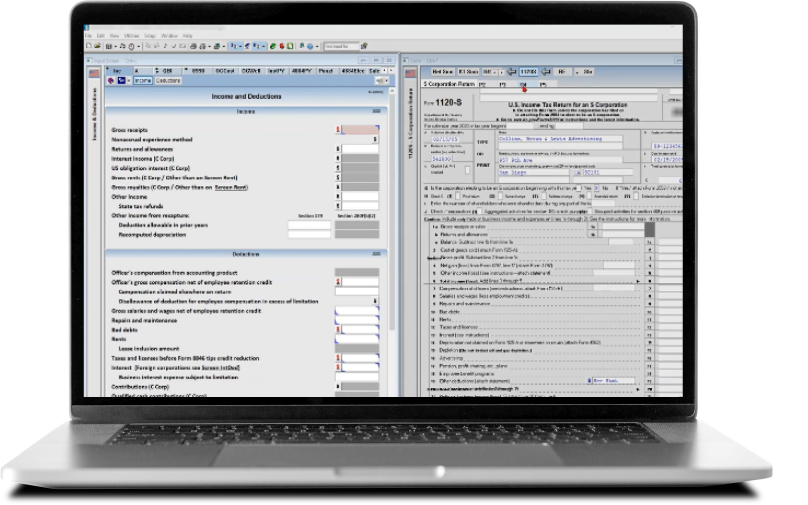Jump to:
| What is the foreign tax credit? |
| What is Form 1116? |
| What is a high tax kickout? |
| Foreign tax credit carryover |
| Helping clients claim the foreign tax credit |
For accountants working with U.S. expatriates, understanding the details of the foreign tax credit and Form 1116 is essential in preventing double taxation of income earned abroad and offsetting taxes paid to foreign governments against U.S. federal income tax liability.
Let’s explore the fundamentals of the foreign tax credit and discuss how tax professionals can best assist clients in claiming it.
What is the foreign tax credit?
The foreign tax credit (FTC) is a tax benefit available in the United States that allows U.S. citizens or resident aliens to offset income taxes paid to foreign countries or U.S. possessions. By claiming this credit, individuals can effectively reduce their U.S. tax liability and avoid double taxation on the same income earned internationally.
Who qualifies for the foreign tax credit?
Here’s a closer look at who qualifies for the foreign tax credit and how they qualify:
- U.S. citizens and residents. U.S. citizens and resident aliens, including green card holders, are eligible for the foreign tax credit. They can claim the FTC for foreign income taxes paid on both earned and unearned income, such as wages, dividends, interest, and capital gains. U.S. nonresident aliens are not eligible for the credit.
- Foreign income source. To qualify for the foreign tax credit, the taxes paid must be on income derived from foreign sources. This typically includes income earned abroad or from foreign investments. Income from U.S. sources, even if it’s received while residing abroad, doesn’t qualify for the FTC.
- Taxpayer’s legal obligation. The taxpayer must have a legal obligation to pay foreign income taxes. This means the taxes paid must not be voluntary or discretionary but rather based on the tax laws of the foreign country.
- Dual taxation agreement. It’s important to consider if there’s a tax treaty between the U.S. and the foreign country in question. Tax treaties can affect the eligibility for and calculation of the FTC. It’s essential to review the specific treaty provisions for guidance.
To help determine if you or your client can claim a credit for paying taxes to a foreign country, use the IRS Interactive Tax Assistant.
NewsletterStay up to date with the latest changes in foreign tax legislation with Checkpoint newsstand. |
|
Is the foreign tax credit refundable?
The foreign tax credit is not refundable, however, it can be a dollar-for-dollar reduction of your client’s U.S. federal income tax liability. In other words, if the credit exceeds U.S. tax liability, the excess cannot be refunded to the taxpayer. Instead, any unused credit can typically be carried back or carried forward to other tax years.
Example usage of the foreign tax credit
Let’s illustrate the application of the foreign tax credit with a real-world example. Suppose one of your clients, a U.S. expatriate working for a multinational corporation like Ford Motor Company, earns a significant portion of their income abroad. Ford operates in numerous countries, and your client is subject to foreign income tax on their earnings in the countries where they work.
Let’s say your client earned $100,000 in foreign income and paid $20,000 in foreign income taxes. In this scenario, your client can claim the foreign tax credit for the $20,000 in foreign taxes paid. If their U.S. federal income tax liability on this income is $15,000, the FTC will offset this liability entirely, resulting in no additional U.S. federal income tax due.
What is Form 1116?
Form 1116 is the document that taxpayers use to calculate and claim the foreign tax credit. This form serves as a critical tool in ensuring your client’s eligibility for and accurate calculation of the FTC.
When is Form 1116 required?
Form 1116 is required when any of the following conditions apply to your client’s tax situation:
- Foreign tax paid. If your client has paid or accrued foreign taxes on income derived from foreign sources, they are typically required to file Form 1116 to claim the FTC. This applies to both individuals and businesses.
- Foreign sourced income. When your client has foreign-sourced income that is subject to both U.S. and foreign income taxes, Form 1116 is necessary to determine the allowable credit against their U.S. federal income tax liability.
- Multiple foreign countries. If your client’s income comes from multiple foreign countries with different tax rates or if they have paid foreign taxes to multiple countries, Form 1116 helps calculate the credit accurately for each country’s tax liability.
Form 1116 instructions
Form 1116 can be complex, and it’s crucial to follow the instructions provided by the IRS carefully. Here’s a simplified overview of the key steps involved in completing Form 1116:
- Identify income categories. Clients should categorize their foreign income into specific baskets, such as general income, passive income, and certain other income categories. Different income categories have distinct rules for calculating the foreign tax credit.
- Calculate the foreign tax credit for each income category. For each income category, taxpayers should calculate the foreign tax credit separately. This involves determining the amount of foreign taxes paid or accrued and applying the relevant FTC limitations.
- Combine FTC amounts. After calculating the FTC for each income category, taxpayers should combine the credit amounts to arrive at the total foreign tax credit for the tax year.
- Complete Form 1116. Taxpayers must complete Form 1116 accurately, providing all necessary information about their foreign income, foreign taxes paid, and the computation of the FTC.
- Attach Form 1116 to tax return. The completed Form 1116 should be attached to the client’s U.S. federal income tax return (e.g., Form 1040).
Navigating Form 1116 requires attention to detail, as errors or omissions can lead to discrepancies in the foreign tax credit calculation, potentially triggering IRS inquiries or audits.
What is a high tax kickout?
A high tax kickout is a provision within the foreign tax credit rules that can impact how the FTC is calculated. This provision is designed to prevent taxpayers from receiving a credit for foreign taxes paid at a rate significantly higher than the U.S. tax rate.
Here’s how the high tax kickout works:
If the foreign tax rate on a particular item of income exceeds 250% of the U.S. tax rate on the same income, the excess foreign taxes paid are not eligible for the FTC. This ensures that taxpayers do not receive an excessive credit for foreign taxes paid.
For example, if your client earns income in a foreign country where the tax rate is 50%, and the U.S. tax rate on the same income is 20%, the high tax kickout provision would come into play. In this case, only 20% of the foreign taxes paid would be eligible for the FTC, and the excess 30% would not qualify.
It’s essential to be aware of the high tax kickout provision when calculating the foreign tax credit to ensure accurate compliance with tax regulations. For more information, check out the foreign tax credit compliance tips from the IRS.
Foreign tax credit carryover
When your clients’ foreign tax credit exceeds their U.S. federal income tax liability for the current tax year, the excess credit does not go to waste. Instead, it can be carried forward or carried back to other tax years, subject to certain limitations. This feature helps taxpayers make the most of their foreign tax credits over time.
Carryback and carryforward options:
- Carryback. In some cases, taxpayers can elect to carry back excess foreign tax credits to the previous tax year (typically one year). This can result in a refund of taxes paid in the prior year if the foreign tax credit exceeds the U.S. tax liability for that year.
- Carry forward. If carrying back the excess credit is not an option or doesn’t fully utilize the credit, taxpayers can carry forward the remaining credit for up to ten years. This means they can apply the excess foreign tax credits against U.S. tax liabilities in future tax years.
Limitations on carryovers:
- Excess credits can be carried back one year and carried forward ten years.
- Credits carried back can only offset taxes paid in the previous year, and any remaining excess is carried forward.
- The general foreign tax credit limit (which is based on total foreign income) applies to carried-back and carried-forward credits.
Assisting your clients in optimizing their foreign tax credit carryovers requires a strategic approach to minimize their overall U.S. tax liabilities.
Helping clients claim the foreign tax credit
Understanding foreign tax credits and earned income is crucial for accountants assisting clients with U.S. expatriate status as it can reduce tax liability and avoid double taxation on foreign-earned income.
Here are some key takeaways to ensure your clients effectively claim the foreign tax credit:
- Confirm your client’s eligibility for the foreign tax credit based on their citizenship, residence status, and the source of their income.
- Ensure compliance with tax treaties, as they can impact eligibility and calculation of the FTC.
- Familiarize yourself with Form 1116 and follow IRS instructions to accurately calculate and claim the foreign tax credit.
- Be aware of the high tax kickout provision and how it may affect the FTC calculation.
- Help clients make the most of excess foreign tax credits by considering carryback and carryforward options but be mindful of limitations.
By providing your clients with comprehensive guidance on the foreign tax credit and Form 1116, you can help them optimize their tax situation and achieve compliance with U.S. tax laws while minimizing their tax liabilities. This expertise is invaluable for accountants who work with U.S. expatriates.
How tax software can help claim the foreign tax credit
Tax software can help accountants calculate the foreign tax credit and reduce the risk of double taxation for their clients. In addition, tax software allows accountants to input financial data from various sources, including foreign income, in a streamlined manner.
Perhaps most importantly, comprehensive tax software receives real-time updates and alerts regarding changes in tax laws and legislation, including those related to the foreign tax credit. This ensures that accountants and clients are aware of any changes that impact their tax obligations.
If you’re an accountant looking to help your clients report on foreign income, SurePrep software can integrate with UltraTax CS, GoSystem Tax RS, CCH Axcess Tax, and Lacerte and can help you reduce manual data entry, ensure compliance, and minimize tax liability.
The AI-powered combination of 1040SCAN, SPbinder, and TaxCaddy integrate with your existing tax software to automate each phase of the tax prep process. Together with Checkpoint Edge, you can be sure you are properly interpreting IRS tax legislation in an ever-changing landscape.
DemoWatch a free demonstration of UltraTax CS professional tax preparation software, or request a live demo tailored to your needs. |
|









